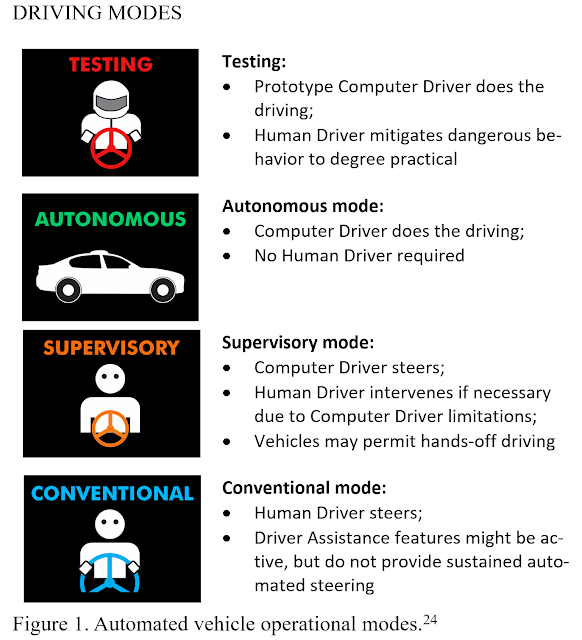I'm delighted that months of collaboration with co-author and law professor William Widen have resulted in a trio of papers that together provide a framework for resolving the vast majority of automated vehicle legal questions. Product liability will still be a thing, but that should be reserved for its more usual role, and not be the sole means of recourse for everyday Computer Driver road mishaps that will displace the everyday Human Driver road mishaps. A tort law approach based on negligence is a far better fit and will require far less disruption to existing legal and regulatory systems while providing a fair basis for compensation for anyone harmed by this novel technology.
The three parts are in three separate SSRN papers intended to be used as a set, although each paper is self-contained. Below are very simplified summaries to give an overview.
25 minute video with overview of the concepts: https://youtu.be/i0ZGSEFHwE8 or https://archive.org/details/l-139-computer-driver
(1) Computer Driver: Define the concept of synthetic negligence for a Computer Driver. A Computer Driver should be held to the same standards of negligence for harm it causes as a Human Driver. The manufacturer should be the responsible party for any negligent behavior on the part of a Computer Driver because they are the ones who should be incentivized to produce safe automated driving systems. The behavioral standard is not an "average driver" but rather a "reasonable driver."
Winning the Imitation Game: Setting Safety Expectations for Automated Vehicles, 25 Minn. J.L. Sci. & Tech. 113 (2023) https://scholarship.law.umn.edu/mjlst/vol25/iss1/5/
Also see this shorter summary paper of the same material from WAISE 2023 for a more general and technical audience: Koopman, P. & Widen, W., "A Reasonable Driver Standard for Automated Vehicle Safety," Safecomp WAISE workshop, Sept. 2023
Also see this Jurist piece on how this might work with criminal law, especially for a Level 3 vehicle in which the driver has been told it is OK not to watch the road: Widen, W. & Koopman, P., Level 3 Automated Vehicles and Criminal Law, Jurist, Aug. 2023
Video about why using product liability for computer drivers is likely to break the court system: https://www.youtube.com/watch?v=WhtxTDRvTOE
(2) Liability Transfer Rules: Define the rules of transfer of liability between the Human Driver and the Computer Driver depending on the operational mode per the summary figure below. Shared responsibility (Human Driver supervises safety of Computer Driver) requires special attention to avoid the person being used as a moral crumple zone. Two key rules come into play regarding the need for effective driver monitoring and the obligation of a person to intervene when it is reasonable that they would know to do so.
The Awkward Middle for Automated Vehicles: Liability Attribution Rules When Humans and Computers Share Driving Responsibilities
https://papers.ssrn.com/sol3/papers.cfm?abstract_id=4444854
(3) Definitions and Statute Outline: Create a set of definitions and statute-oriented rules to make the first two papers more actionable. We envision this as a robust starting point for state legislatures that find this approach useful.
Liability Rules for Automated Vehicles: Definitions & Detail
https://papers.ssrn.com/sol3/papers.cfm?abstract_id=4444848
